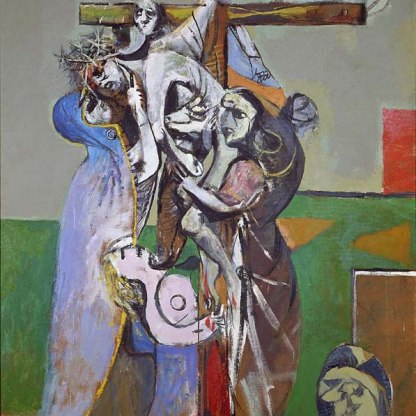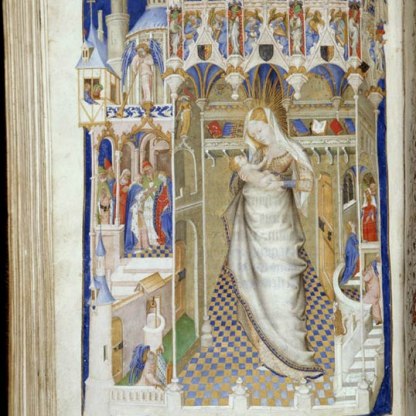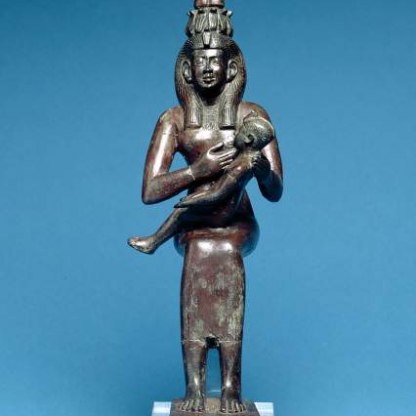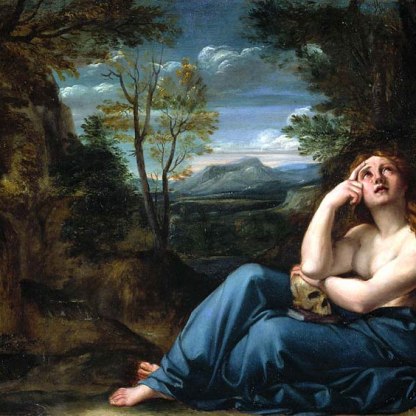The Virgin's Breasts
And it came to pass, as [Jesus] spake these things, a certain woman of the company lifted up her voice, and said unto him, Blessed is the womb that bare thee, and the paps that thou hast sucked.
Luke, 11, 27
In ancient art, the Egyptian goddess Isis was often shown suckling her child Horus. A small bronze sculpture dating from between 715 and 525 BCE in the Fitzwilliam [E.122.1954], depicts this divine mother and son. It is possible that this model inspired early Christian artists in their depictions of the Virgin feeding the child. But although the subject is found in Byzantine art, it did not become popular again in the West until the fourteenth century.
By this time vials purportedly containing the breast milk of the Virgin had become highly coveted as relics. In the sixteenth century, the Reformation leader John Calvin was withering in his disdain for the excesses of this cult:
There is no town so small, nor convent so mean, that it does not display some of the Virgin's milk, there is so much that if the Holy Virgin had been a cow or a wet nurse all her life, she would have been hard put to yield up such a great quantity.
The subject of Mary feeding her son was popular in medieval art because of the stress it lays upon Christ's humanity. If the Son of God has to suckle like any other baby, then it is easy to believe that he truly has become man and shares in the human condition – imperfect since Adam took the apple in the Garden of Eden and women first began to suckle their young.
In Mary's role as intercessor between Heaven and Earth, she is sometimes shown baring her breasts to her son. In one Italian example the scene is accompanied by the inscription 'Dearest son, because of the milk I gave you, have mercy upon them.' The milk of the mother provides the common link between Christ and mankind.
The very breasts themselves were seen as purgers of sin. The following is a translation of a fifteenth-century Latin hymn, De uberibus B. Mariae Virginis – 'On the Breasts of the Virgin Mary:
Little breasts of the Mother Mary Shining like little torches Offering milk to the Son They are little sparks of nourishment Through which sins are abolished, Smelling of perfume.
There were even stories of the Virgin giving suck to the faithful, most famously to the twelfth-century St Bernard of Clairvaux. The story goes that he was reciting the popular medieval hymn Ave, stella maris. When he got to the line 'show yourself a mother', the Virgin appeared to him and, squeezing her breast, allowed a few drops of milk to fall upon his lips. The scene was sometimes depicted in art.
A thirteenth-century poem tells the story of a monk whose mouth was infested with ulcers. While sleeping, he dreamed of the Mother of God and:
with much sweetness and much delight, from her sweet bosom, she drew forth her breast, that is so sweet, so soft, so beautiful and placed it in his mouth, [and] gently touched him all about and sprinkled him with her sweet milk.
Mary is revealed as the mother and nurse to all mankind, not just her divine son.
Whether the breasts of the Virgin were ever actually interpreted erotically, in the way for instance that Palma Vecchio's naked Venus [109], might be, is doubtful. But as artists began using a greater degree of naturalism in representing the human body, the subject became more controversial. By the mid-sixteenth century, certain viewers found the naked breast of the Mother of God indecorous and at the council of Trent in 1563, nude representations of sacred characters were prohibited.
Other highlight objects you might like
Other pathways and stories you might like
Sign up to our emails
Be the first to hear about our news, exhibitions, events and more…






